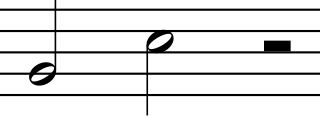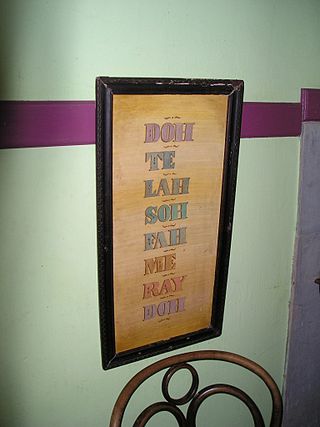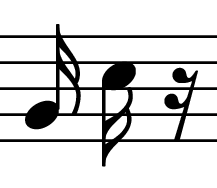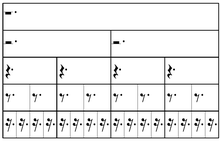
Music notation or musical notation is any system used to visually represent aurally perceived music played with instruments or sung by the human voice through the use of written, printed, or otherwise-produced symbols, including notation for durations of absence of sound such as rests.
The time signature is a convention in Western music notation to specify how many beats of a particular note value are contained in each measure (bar). The time signature is a notational device representing the meter, an auditory feature of the music.
In music, an accidental is a note of a pitch that is not a member of the scale or mode indicated by the most recently applied key signature. In musical notation, the sharp, flat, and natural symbols, among others, mark such notes—and those symbols are also called accidentals. In some kinds of musical style, there are also the half sharp as well as half flat, sometimes also called quarter tone.

A quarter note (American) or crotchet (British) is a musical note played for one quarter of the duration of a whole note. Quarter notes are notated with a filled-in oval note head and a straight, flagless stem. The stem usually points upwards if it is below the middle line of the staff, and downwards if it is on or above the middle line. An upward stem is placed on the right side of the notehead, a downward stem is placed on the left. The Unicode symbol is U+2669.

In music, a half note (American) or minim (British) is a note played for half the duration of a whole note and twice the duration of a quarter note. It was given its Latin name because it was the shortest of the five note values used in early medieval music notation. Half notes are notated with a hollow oval notehead like a whole note and straight note stem with no flags like a quarter note. The half rest denotes a silence of the same duration. Half rests are drawn as filled-in rectangles sitting on top of the middle line of the musical staff, although in polyphonic music the rest may need to be moved to a different line or even a ledger line. As with all notes with stems, half notes are drawn with upward stems on the right when they are below the middle line of the staff and downward stems on the left when they are on or above the middle line. In vocal music, notes on the middle line have a downward stem instead of an upward stem.

An eighth note (American) or a quaver (British) is a musical note played for one eighth the duration of a whole note (semibreve). Its length relative to other rhythmic values is as expected—e.g., half the duration of a quarter note (crotchet), one quarter the duration of a half note (minim), and twice the value of a sixteenth note. It is the equivalent of the fusa in mensural notation.
Sheet music is a handwritten or printed form of musical notation that uses musical symbols to indicate the pitches, rhythms, or chords of a song or instrumental musical piece. Like its analogs – printed books or pamphlets in English, Arabic, or other languages – the medium of sheet music typically is paper. However, access to musical notation since the 1980s has included the presentation of musical notation on computer screens and the development of scorewriter computer programs that can notate a song or piece electronically, and, in some cases, "play back" the notated music using a synthesizer or virtual instruments.

In music, a double whole note (American), breve, or double note lasts two times as long as a whole note. It is the second-longest note value still in use in modern music notation. The longest notated note is the longa, which could be double or triple the length of a breve, although its use is most commonly found in early music. The longest notated note is the maxima.
In musical notation, a bar is a segment of music bounded by vertical lines, known as bar lines, usually indicating one of more recurring beats. The length of the bar, measured by the number of note values it contains, is normally indicated by the time signature.
In music, the terms additive and divisive are used to distinguish two types of both rhythm and meter:
In music, a tuplet is "any rhythm that involves dividing the beat into a different number of equal subdivisions from that usually permitted by the time-signature " This is indicated by a number, or sometimes two indicating the fraction involved. The notes involved are also often grouped with a bracket or a slur.

Braille music is a braille code that allows music to be notated using braille cells so music can be read by visually impaired musicians. The system was incepted by Louis Braille.
In music, an accent is an emphasis, stress, or stronger attack placed on a particular note or set of notes, or chord, either as a result of its context or specifically indicated by an accent mark. Accents contribute to the articulation and prosody of a performance of a musical phrase. Accents may be written into a score or part by a composer, or added by the performer as part of their interpretation of a musical piece.
The numbered musical notation is a cipher notation system used in China, and to some extent in Japan, Indonesia, Malaysia, Australia, Ireland, the United Kingdom, the United States and English-speaking Canada. It dates back to the system designed by Pierre Galin, known as Galin-Paris-Chevé system. It is also known as Ziffernsystem, meaning "number system" or "cipher system" in German.

A fermata is a symbol of musical notation indicating that the note should be prolonged beyond the normal duration its note value would indicate. Exactly how much longer it is held is up to the discretion of the performer or conductor, but twice as long is common. It is usually printed above but can be occasionally below the note to be extended.

Mensural notation is the musical notation system used for polyphonic European vocal music from the late 13th century until the early 17th century. The term "mensural" refers to the ability of this system to describe precisely measured rhythmic durations in terms of numerical proportions between note values. Its modern name is inspired by the terminology of medieval theorists, who used terms like musica mensurata or cantus mensurabilis to refer to the rhythmically defined polyphonic music of their age, as opposed to musica plana or musica choralis, i.e., Gregorian plainchant. Mensural notation was employed principally for compositions in the tradition of vocal polyphony, whereas plainchant retained its own, older system of neume notation throughout the period. Besides these, some purely instrumental music could be written in various forms of instrument-specific tablature notation.

In musical notation, a beam is a horizontal or diagonal line used to connect multiple consecutive notes to indicate rhythmic grouping. Only eighth notes (quavers) or shorter can be beamed. The number of beams is equal to the number of flags that would be present on an unbeamed note. Beaming refers to the conventions and use of beams. A primary beam connects a note group unbroken, while a secondary beam is interrupted or partially broken.

Tonic sol-fa is a pedagogical technique for teaching sight-singing, invented by Sarah Ann Glover (1785–1867) of Norwich, England and popularised by John Curwen, who adapted it from a number of earlier musical systems. It uses a system of musical notation based on movable do solfège, whereby every note is given a name according to its relationship with other notes in the key: the usual staff notation is replaced with anglicized solfège syllables or their abbreviations. "Do" is chosen to be the tonic of whatever key is being used. The original solfège sequence started with "Ut", the first syllable of the hymn Ut queant laxis, which later became "Do".

In music, a 1/16, sixteenth note (American) or semiquaver (British) is a note played for half the duration of an eighth note (quaver), hence the names. It is the equivalent of the semifusa in mensural notation, first found in 15th-century notation.



















